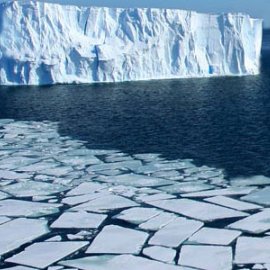The New North
-
English
-
ListenPause
I’m Peter Neill, Director of the World Ocean Observatory. The new north – a phrase that slowly seeps into the geopolitical discussion and suggests that in the changes in the northern latitude may be found an intimated, as yet ill-defined set of developments, built on first actions taken by those looking to exploit the future and to lay claim to the opportunity that will occur as the ice melts, the ecosystem adapts, and the unknown becomes known. For some time now, we have been aware of such things in the form of submarine passages and territorial claims in the Arctic, of principles of governance and proposed collaboration by vested nations, and of incursions of natural resource exploration and first exploitation of what has been impossible to reach. At one time, a passage west to east above Canada was the stuff of unique adventure, west to east above Russia was seemingly impossible. The conditions to be found there were severe, impassable, impenetrable, dangerous. But today we know that oil platforms exist and are planned to line the entrances to these northern passages ever more accessible as temperature change and melting ice cracks open new possibilities, new sea lanes, new ground on the ocean floor from which to draw oil and gas to feed our insatiable demand for fossil fuels. Russia, Canada, and the United States contract for new icebreakers. An increasing number of ships feel their way across this new northern route, threatening pristine ecosystems and wild life with accident and toxic consequence, causing various global enterprises to rethink their business strategy, new investment, and acquisition of physical resources to serve the demands of new enterprise. The smart money finds its way north. The most intrepid step up to the risk involved. The engineering and technology in which we place so much faith is advanced and applied, even as untested tools in unpredictable conditions. The old north is to be transformed as the glaciers calve, the animal migration routes disappear, and the few native communities are bought out, displaced, and forgotten. The old north is uninterrupted tundra, universal cold, plants that adapt and thrive, ready to bloom in the Arctic spring. The new north is port facilities, pipeline routes, service outposts, communications towers and cables, all the systems required to accumulate and move commercial volumes expeditiously for scheduled delivery to consumers below and beyond. What happens when the oil spills and some comes ashore but more sinks and circulates beneath the ice beyond any futile attempts to clean up or mitigate the damage? What happens when the storms and ice dynamics block narrow navigation channels, or a ship collides with the ice? What happens to the survivors? What happens when the unexpected, the unpredictable accident, the inevitable human error occurs and the consequences are beyond rectification? We know what that looks like from example after example in more temperate clime and less exacting conditions. We know the damage done. There are those who argue that we don’t need to go there, into the new north. That we should protect this unique and fragile place from our ambitions and endeavors. That should look to meet our needs for energy or transport in alternative, less invasive ways. That we should let be the far north as original, inviolate, pristine, and wild. There are courageous advocates making their voices known in opposition to this corruption of the last pure place on earth. ¬¬¬ Why do we endlessly pursue this behavior? It is surely as old as history itself, but the situation today may be different, first by the number of us on earth who need equitable distribution of water, food, energy, health, and security, and, second, by our proven capacity to invent our way forward when our conventional knowledge becomes counter-effective, inefficient, uneconomical, and destructive. How do we balance such demand with adequate supply for survival? Is that not the key question for this time? The attraction of the new north is based on exhausted ideas. The real explorers and risk-takers today are the inventors of alternative technologies, the proponents of new systems of governance, and the opportunists who see that we can meet our future needs through imagination and entrepreneurial pursuit of new ideas. Let’s incentivize, subsidize and invest in these, forgo the limited rewards and last vestiges of the old ways, and keep the new north new by leaving it alone. We will discuss these issues, and more, in future editions of World Ocean Radio.
Arctic opportunities and territorial claims are on the rise as temperatures change and the ice melts. Once impassable, the Arctic is now increasingly accessible to drilling, shipping traffic, and other global enterprise. In this episode of World Ocean Radio, host Peter Neill describes what a transformed Arctic might look like, and suggests that we should be encouraging, subsidizing, and investing in alternative technologies so that we may leave the pristine North alone.
Peter Neill, host of World Ocean Radio, provides coverage of a broad spectrum of ocean issues from science and education to advocacy and exemplary projects. World Ocean Radio, a project of the World Ocean Observatory, is a weekly series of brief audio essays available for syndicated use at no cost by community radio stations worldwide. Contact us for more information.
- Login to post comments



